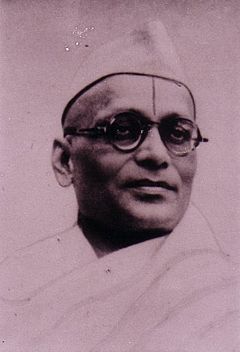- P. T. Narasimhachar
-
P. T. Narasimhachar (Pu Ti Na) 
© Kamat's PotpourriBorn 17 March 1905
Melukote, Nagamangala taluk, Mandya district, KarnatakaDied 23 October 1998 (aged 93)
Bangalore, KarnatakaPen name Pu Ti Na (ಪು ತಿ ನ) Occupation Writer, Poet Nationality India Genres Fiction Literary movement Kannada: Navodaya Purohita Thirunarayana Narasimhachar (Kannada: ಪುರೋಹಿತ ತಿರುನಾರಾಯಣ ನರಸಿಂಹಾಚಾರ) (17 March 1905 – 23 October 1998), commonly known as PuTiNa, was a playwright and poet of the Kannada language. Along with, Kuvempu and D. R. Bendre, he forms the well-known trio of Kannada Navodaya poets.[1] He is a Sahitya Akademi fellow and the winner of the Pampa Award given by the Government of Karnataka in 1991.[2]
Contents
Life and career
PuTiNa was born on 17 March 1905 into an orthodox Tamil Brahmin family in the town of Melkote in Mandya district of Karnataka.[3] His father was Tirunarayana Iyengar and mother was Srirangamma. Sanskrit was an important part of his education and upbringing, as was English, being the primary language of instruction at the time. He was also exposed to, and learned several other languages, including French and Tamil. This background in so many languages enabled PuTiNa to expand his intellectual horizons, and he did so, studying western literature extensively.
PuTiNa's intellect was really cultivated in his college years at Maharaja College in Mysore, where he was greatly influenced by his English professor TiNamSri, who recognized his talent for poetry; the former President of India, Dr. S. Radhakrishnan, who was then a professor at the college; and the renowned Indian philosophy professor, Hiriyanna. However, despite his proficiency in such a multitude of languages and varied intellectual background, PuTiNa was most interested in the local language of Kannada.
Apart from being a writer, PuTiNa also worked in the army of Mysore state. He also worked in the legislature of the Government of Mysore state.[4] He also served as a member of the Mysore University committee looking at revising the English-Kannada dictionary. He died on 23 October 1998.
Literary contributions
PuTiNa was one of the writers who gave birth to the Navodaya style of Kannada literature. According to Prof. Lakshminarayana Bhat, "At a broad level, the growth of the Navodaya style of literature resembles the growth of the writings of PuTiNa".[5] In his first collection of poems Hanathe, he conveyed profound insights into significant moments in life by using simple language and style. Many of PuTiNa's writings speak in detail about the beauty and majesty of nature, that borders on the spiritual.[6] Some of his well known writings include Ahalye which subtly talks of the conflicts between kama and dharma and Gokula Nirgamana which talks of the departure of Krishna from Gokula.[7]
PuTiNa has also written many essays, that despite being essays, reflect his dominant poetic personality.[8] While some of his essays portray everyday situations in general, others are more reflective and moralistic in nature.
Awards and recognitions
PuTiNa's many awards and recognitions include:
- Central Sahithya Academy Prize for Hamsa-Damayanthi and Gitarupakas
- Honorary Doctor of Literature from Mysore University
- President of 53rd Kannada Sahithya Sammelana, 1981, Chikmagalur
- Granthaloka award for Sriharicharite, 1989
- Pampa award, 1991
- Padmasri from the Government of India, 1991
Bibliography
Collection of poems
- Hanate
- Mandaliru
- Sharadayaamini
- Hrudaya vihari
- Ganesha darshana
- Rasa Sarasvati
- Maley Degula
- Irula Meragu
- Haley Chiguru - Hosa Beru
Musical dramas
- Vasanta Chandana
- Seeta Kalyana
- Ahalye
- Gokula Nirgamana
- Shabari
- Doniya Binada
- Vikatakavi
- Ramapatabisheka
Collection of stories
- Ramachariya Nenapu
- Rathasaptami and other stories
- Sri Rama Pattabhiskekham
- Hamsa Damayanti
Notes
- ^ K. M. George (1992), p642
- ^ P. T. Narasimhachar (2001), Back cover
- ^ "Birth centenary of PuTiNa". ThatsKannada.com. http://thatskannada.oneindia.in/literature/articles/2004/170304putina.html.
- ^ "House of PuTiNa at Melkote is a cultural icon". ThatsKannada.com. http://thatskannada.oneindia.in/news/2000/06/14/putinahouse.html. Retrieved 2009-03-21.
- ^ "An analysis of Pu. Ti. Narasimhachar's work". OurKarnataka.com. http://www.ourkarnataka.com/skharihareshwara/putina1.htm. Retrieved 2009-03-21.
- ^ K. M. George (1992), p174
- ^ Sisir Kumar Das (1995), p766
- ^ Amaresh Datta (1988), p1220
References
- K. M. George (1992) [1992]. Modern Indian Literature, an Anthology: Surveys and poems. Sahitya Akademi. ISBN 9788172013240.
- P. T. Narasimhachar (2001) [2001]. Hill Temple. Sahitya Akademi. ISBN 9788126008148.
- Amaresh Datta (1988). Encyclopaedia of Indian literature vol. 2. Sahitya Akademi. pp. 1142. ISBN 8126011947.
- Sisir Kumar Das, various (1995). A History of Indian Literature. Sahitya Akademi. ISBN 8172017987.
External links
Categories:- Kannada poets
- People from Mandya
- 1905 births
- 1998 deaths
- Recipients of the Sahitya Akademi Award in Kannada
- Kannada dramatists and playwrights
Wikimedia Foundation. 2010.
